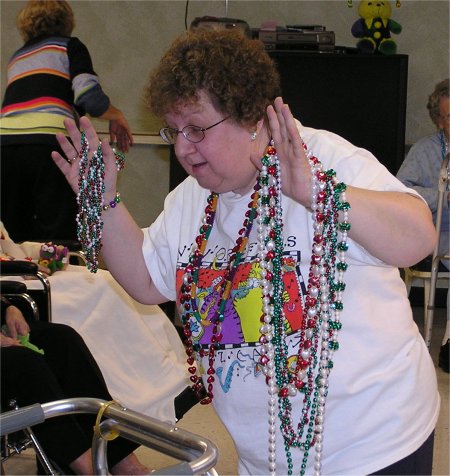
Joyce tells residents they must say, "Throw me something mister."
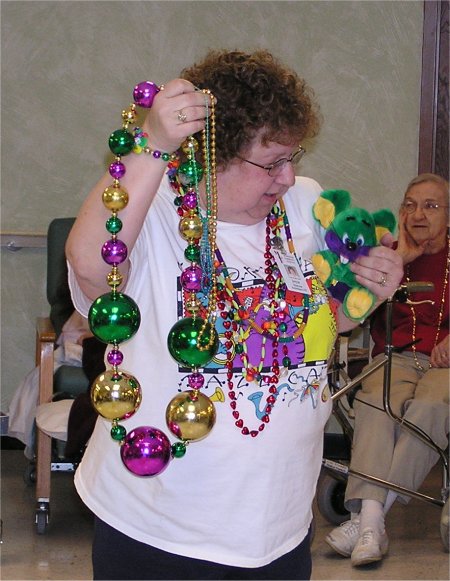
Joyce shows the different sizes of beads.
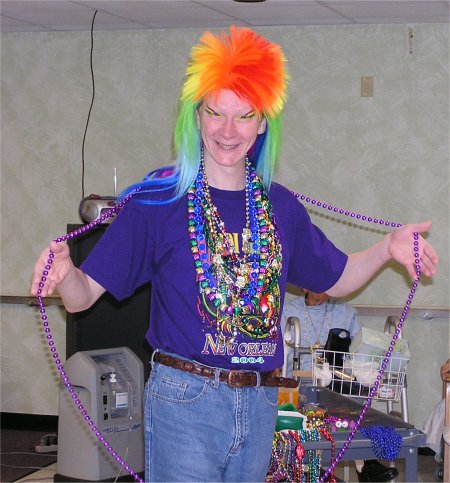
Scott Akerman shows off the 6 ft long strand of beads. They are said to be the most expensive and people feel special if they receive them.
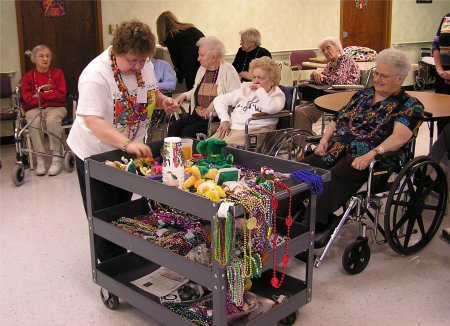
Joyce shows the residents her cart filled with some of the different items that are thrown from the floats during the parades.
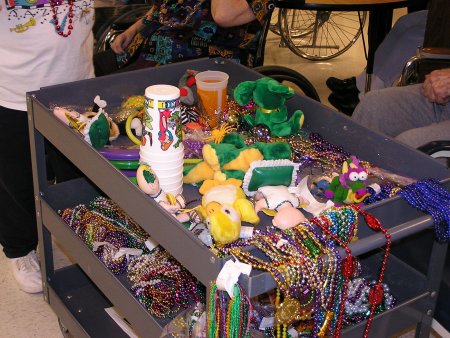
Close-up of the cart.

Employees got involved too.
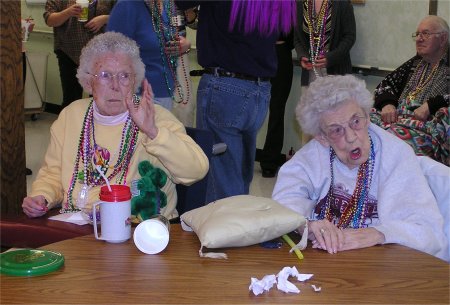
Laverne Erdman and Ruth Bristle calling, "Throw me something mister."

Marian Wiersema shows all her "treasures" she received during the celebration.

The "baby" that is hidden in the King Cakes.
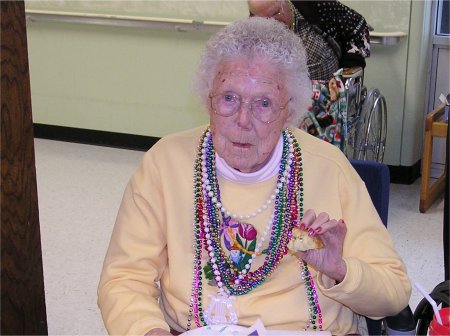
Two King Cakes were baked for the residents. Laverne Erdman found the first one.

Joe Tiesman found the other "baby".

Gayle Schmidt does "The Worm" as part of the fun for the Mardi Gras celebration.
|
“Throw me something mister,” was heard throughout the Four Seasons Living Center of Morrison Community Hospital Friday morning as activities director Joyce Zajicek and other helpers tossed beads and other trinkets to the residents. Joyce has attended Mardi Gras activities in New Orleans for the past seven years and shared the fun with residents for the last six. Throughout the week different activities had been planned to lead up to their festivities on Friday. Staff had been wearing beads, jazz and gospel music had been played and Joyce had set out travel logs for the residents to read and look at.
Joyce began the program with some background history. She explained the difference of Carnival and Mardi Gras. Carnival, which is Latin for "kiss your flesh goodbye," is a long season between Christmas and Lent. Carnival officially begins in New Orleans on the Feast of Epiphany, or Twelfth Night - Jan. 6 - and continues until the midnight of Fat Tuesday, the day before Ash Wednesday. On Ash Wednesday nothing is open. The date for Ash Wednesday, of course, changes from year to year depending on the date of Easter.. Mardi Gras can occur as early as Feb. 3 and as late as March 9. Mardi Gras ends the Carnival season.
The best way to get beads free is to attend Mardi Gras parades. Each float rider has to provide his own "throws," mostly thousands of beads. But it is not just beads that are thrown from the floats according to Joyce. “They throw anything and everything, from coconuts to teddy bears, cups, footballs, magnets, and of course the traditional beads. Floats in the parades can be three stories high so you have to pay attention as not to get hit in the head with something that is being thrown from the float.”
The Mardi Gras celebrations can generate up to $1 billion per month. A lot of it is sold in beer but there can be over 100 parades throughout the season. During the parades, trinkets that fall to the ground should be left because if you reach down to get it you just might find yourself getting stepped on. Some of the parades can last as long as 4-5 hours and can be 10 miles long.
The colors for Mardi Gras are purple, green and gold. That year’s Rex chose the colors of Carnival in 1872. By some accounts, the colors were chosen because Rex thought they looked good together. Twenty years later, for the 1892 parade, Rex declared that the colors had meaning: purple for justice, green for faith and gold for power.
One of the most beloved traditions in New Orleans is that of the King Cake. As part of the celebration of Mardi Gras, it is traditional to bake an oval cake in honor of the three kings who visited the baby Jesus on the twelfth day after Christmas, “Epiphany”, “Twelfth Night”, or “Kings Day” thus bringing the name - King Cake. The shape of a King Cake symbolizes the unity of faiths. Each cake is decorated in the traditional Mardi Gras colors A small baby, symbolizing the baby Jesus, is baked into each cake. Today, many additional varieties of King Cake are also available, with fillings such as cream cheese, strawberry, apple, and lemon.
The New Orleans tradition, begun in the 1870s, uses many European customs. In New Orleans, King Cake parties are held throughout the Mardi Gras season. Like the biblical story, the "search for the baby" adds excitement, as each person waits to see in whose slice of cake the baby will be discovered. While custom holds that the person who finds the baby in their slice will be rewarded with good luck, that person is also traditionally responsible for bringing the King Cake to the next party or gathering.
An easy King Cake recipe follows:
King Cake Recipe
Ingredients
· 1 can of cinnamon rolls, with icing
· 3/4 cup of sugar, separated into 3 parts of 1/4 each
· food coloring
Separate the cinnamon rolls and roll them out by hand so that they look like a hot dog. Shape the roll into an oval, pinch the ends together, and place on a cookie sheet. Cook as directed.
While they are cooking, use food coloring to dye sugar. Make one part purple using blue and red, one part green, and one part gold using yellow. When they are finished cooking, ice the tops with the white icing. Sprinkle the different colors of sugars alternating as you go around the oval.
If you have more time and want to make an official King Cake this is the recipe to use:
Official Mardi Gras King Cake Recipe
Ingredients
1/2 cup warm water (110 to 115 degrees)
2 packages active dry yeast
1/2 cup plus 1 teaspoon sugar
31/2 41/2 cups unsifted flour
1 teaspoon nutmeg
2 teaspoons salt
1 teaspoon lemon zest
1/2 cup warm milk
5 egg yolks
1 stick butter cut in slices and softened, plus 2 tablespoons more
1 egg slightly beaten with a tablespoon of milk
1 teaspoon cinnamon
1 tiny plastic doll (not more than 1")
Directions
Pour the warm water into a small shallow bowl and sprinkle yeast and 2 teaspoons sugar into it. Allow the yeast and sugar to rest for three minutes, then mix thoroughly. Set bowl in a warm place for 10 minutes until yeast bubbles up. Combine 31/2 cups of flour, remaining sugar, nutmeg and salt and sift into a large mixing bowl.
Stir in lemon zest. Separate center of mixture to form a hole and pour in yeast mixture and milk. Add egg yolks and using a wooden spoon, combine dry ingredients into the yeast/milk mixture. When mixture is smooth, beat in 8 tablespoons butter, 1 tablespoon at a time and continue to beat 2 minutes or until dough can be formed into a medium soft ball.
Place ball of dough on floured surface and knead, gradually adding up to 1 cup more of flour. When dough is no longer sticky, knead 10 minutes more until shiny and elastic.
Using a pastry brush, coat the inside of a large bowl evenly with one tablespoon softened butter. Place dough ball in the bowl and rotate until the entire surface is buttered.
Cover bowl with a heavier kitchen towel and allow dough to rise in a warm place for about 11/2 hours or until it doubles in volume. Coat a large baking sheet with one tablespoon of butter and set aside. After the first rising, place the dough on a floured surface and punch it down with a heavy blow. Sprinkle cinnamon, then pat and shape the dough into a long 'snake' or 'cylinder'. Form a twist by folding the long cylinder in half, end to end, and pinching the ends together. Then twist the dough. Form a ring with the completed twist pinch the ends together. Place the completed ring on the buttered baking sheet, cover it with a towel and allow it to rise for 45 minutes or until it doubles in volume.
After the second rising, brush the top and sides of the cake with the egg and milk wash. Bake in a preheated oven at 375 degrees for 25-35 minutes or until golden brown. Cool on a wire rack and hide the plastic baby in the cake.
Icing (2 parts)
Colored sugar -
Green, purple and yellow coloring paste (sold with cake decorating supplies)
12 tablespoons sugar
Divide sugar into three portions (for green, yellow and purple).
Add a tiny amount of the coloring paste to each sugar portion. Try mixing the sugar and colored pasted between your palms for best results. Set aside.
Poured icing
3/4 cups confectioners sugar
1/4 cup lemon juice
36 tablespoons of water
Combine ingredients until smooth, adding more water if it's too thick. Spoon icing over top of cake. Immediately sprinkle on colored sugars, alternating between the three colors. Serve in 2"3" pieces.
When the cake was served, if a girl found the lucky token - "baby" — she was obligated to have the party the following week. The young man she designated to be her king was responsible for supplying the king cake. Accordingly, if a young man found the token, he would designate one of the girls to be his queen. However, in keeping with the traditional custom of the reigning queen assuming the role of host, she was still be expected to throw the next party.
Joyce also told the residents, “Everyone there is extremely polite and nice.” And very accommodating to those who don’t always know the finer points as she found herself being told that she was putting her garbage into a garbage can that was being used by a gentleman who had it in place to collect his souvenirs from the parade.
by Dawn Zuidema, theCity1.com
February 1, 2005
|

